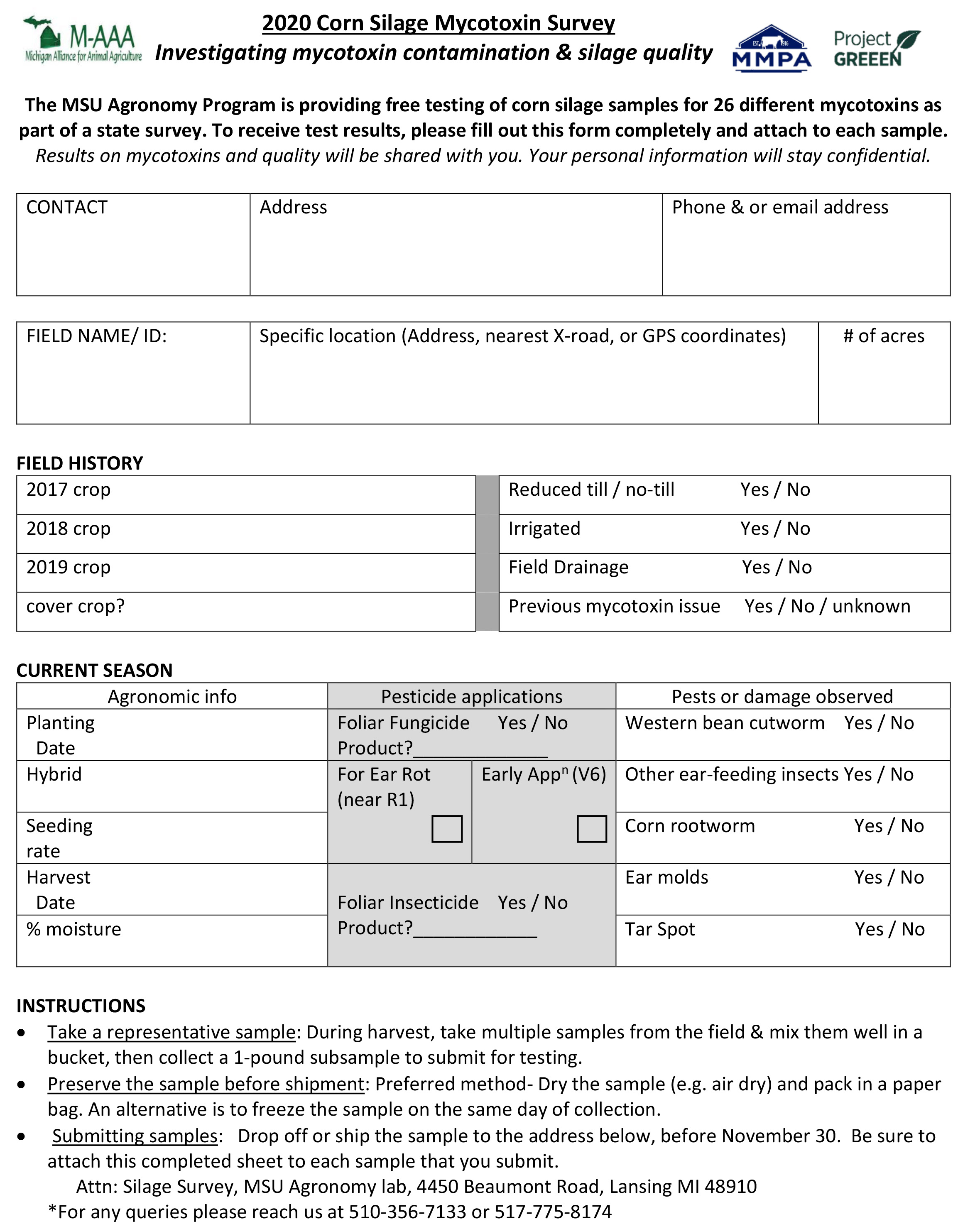Corn silage mycotoxins: Invitation to submit new samples and 2019 results
Submit samples of corn silage for a free mycotoxin analysis as part of MSU research survey.
Corn silage harvest will soon begin across Michigan. Corn silage is a great feed for ruminants, like cattle, providing energy and fiber to keep them healthy and growing or milking. However, under some weather conditions, quality issues can arise due to fungal infection of ears and stalks, resulting in the production of mycotoxins. Contamination of animal feed by mycotoxins, such as deoxynivalenol (DON or commonly known as VOM), zearalenone (ZON) and fumonisins, have been on the rise in Michigan and other northern U.S. production regions over the last few growing seasons.
Mycotoxins are secondary metabolites produced by specific fungal species, such as Fusarium graminearum that produces DON. A combination of optimal (cool and wet) weather conditions favorable to fungal infection and hybrid susceptibility can result in ear and stalk rot infection and associated preharvest mycotoxin contamination. Moreover, feeding by birds, western bean cutworm and other ear feeding insects in conventional and some Bt hybrids can open the ear for secondary infections and mycotoxin accumulation.
Some mycotoxins can cause loss in milk production, poor reproductive performance, sickness or even death of animals. When present in sufficient concentrations in the diet, mycotoxins can have a serious economic impact on farms. Very often, mycotoxins coexist in silage and their impacts on the health of livestock may be synergistic. This makes it difficult to determine safe levels (thresholds) for individual mycotoxins.
In 2019, a research project aiming at reducing this mystery and enabling farmers to reduce their risk was initiated by Michigan State University. Farmers were invited to send in their silage samples for mycotoxin analysis. Growers from nine Michigan counties sent in silage samples. All of the samples tested positive for at least one mycotoxin. Of the 26 mycotoxins for which samples were analyzed, 24 were found in at least one of the samples. Three mycotoxins (DON, ZON and beauvericin) were reported in all samples.
All the samples had co-occurrence of two or more mycotoxins. However, the values of toxins reported in most samples were fairly low, and there were only few samples which mycotoxin levels were greater than the threshold. For example, only 9% of the samples had DON and ZON levels greater than the threshold (5 and 1 parts per million, respectively). In 2016 and 2018 growing seasons, corn silage showed higher levels of mycotoxins and remind us that each year will have different levels of mycotoxins according to environmental conditions.
Results from 2019 indicated that mycotoxins are widespread in corn silage across Michigan. However, more samples over multiple years are needed to reach any conclusions. While some farmers may feed a “binder” to tie up the toxin in the animal’s digestive tract, this is not always effective and is only a treatment after the animal has already ingested toxins. Since there are few ways to overcome problems once mycotoxins are present in corn, prevention of mycotoxin accumulation in the field is essential. Mycotoxin content in a bunker silo will not decrease or be eliminated with corn silage fermentation. Management practices that can be used to minimize mycotoxin production in a corn field include hybrid selection with insect protection traits, fungicide application, scouting and spraying for ear feeding insects, crop rotation, tillage and early harvesting.
MSU is continuing research to determine the effects of management practices, insect damage and weather conditions on mycotoxin development in corn. Michigan corn farmers are invited to be a part of this research. You can submit corn silage samples for free testing of 26 different mycotoxins and quality analysis. Collect approximately 1-pound samples from various locations in the same field and then either dry or freeze them soon after collection. A data sheet along with sample collection instructions is available and can be used to record detailed field information and sent in along with samples. This information must be completed before samples will be analyzed. Results will be communicated back to the farmers.

Participation by corn silage producing farmers in this study will enable MSU researchers and MSU Extension educators to better help farmers improve controlling mycotoxins and therefore improve cattle performance.
Funding for this project is provided by the Michigan Alliance for Animal Agriculture, Project GREEEN and Michigan Milk Producers Association. Farmers that are interested in participating should contact Michigan State University Extension Educators Phil Durst at 989-387-5346, Phil Kaatz at 810-338-5242, Martin Mangual at 787-378-1720 or graduate student Harkirat Kaur at 510-356-7133.



 Print
Print Email
Email